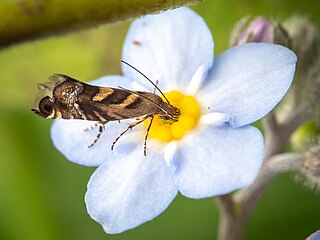
Glyphipterix tungella is a species of sedge moth in the genus Glyphipterix. It is endemic to New Zealand and is found throughout the country. Larvae mine the leaves of small sedges. Adults of this species are day flying and inhabit sheltered scrub or grassy areas and forest clearings.
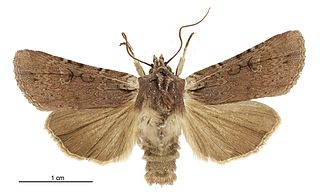
Ichneutica omoplaca is a moth of the family Noctuidae. It is endemic to New Zealand. It is widespread from the Bay of Plenty in the North Island down to Southland in the South Island. Specimens have also been collected from the Auckland Islands. It lives in a variety of habitats including beech forest clearings and tussock grasslands. This species has been recorded that some of the larval hosts of this species include Poa cita, Dactylis glomerata and it has been reared on Plantago lanceolata. The larva is undescribed but pupae have been found in a pine plantation in soil under weeds. Adults of this species are on the wing from October to March. The adult moths are variable in appearance but the diagnostic feature is the pale ochreous to white colouring between the basal streak and the costa which contrasts with the ground colour of the forewing.

Scoparia chalicodes is a species of moth in the family Crambidae. This species was named by Edward Meyrick in 1884. Meyrick gave a fuller description of this species in 1885. S. chalicodes is endemic to New Zealand.
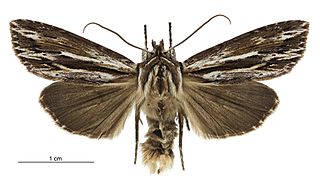
Ichneutica similis is a moth of the family Noctuidae. It is endemic to New Zealand. This species is found only in certain parts of the North Island, in the western side of the South Island and on Stewart Island. It inhabits peatlands as well as inland and coastal wetlands. The life history of this species is unknown and the host species of its larvae has yet to be confirmed. It has been hypothesised that larval host species might be within the Empodisma genus as well as possibly the species Apodasmia similis.
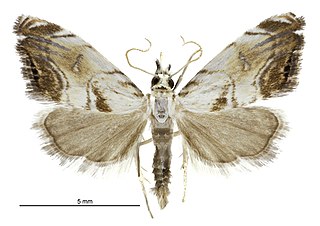
Glaucocharis harmonica is a moth in the family Crambidae. This species was described by Edward Meyrick in 1888. It is endemic to New Zealand and is found in the North and South Islands. It inhabits lowland to subalpine native forest. It has been hypothesised that there are two broods per year. The larval hosts are unknown. Adults are on the wing from October until January.
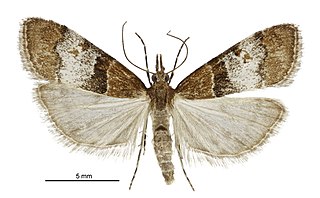
Antiscopa acompa is a moth in the family Crambidae. It was first described by Edward Meyrick in 1884. It is endemic to New Zealand and is found both the North and South Islands. The species inhabits native forest and adult moths are attracted to light.
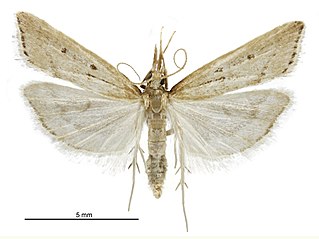
Antiscopa elaphra is a moth in the family Crambidae. It is endemic to New Zealand and has been observed in both the North and South Islands. Adults of this species are on the wing from August until March and are attracted to light. In 2020 this species had its DNA barcode sequenced.

Eudonia leptalea is a moth in the family Crambidae. This species is endemic to New Zealand, including the Chatham Islands.

Eudonia oreas is a moth in the family Crambidae. It was named by Edward Meyrick in 1884. This species is endemic to New Zealand.
Eudonia perierga is a moth in the family Crambidae. It was described by Edward Meyrick in 1885. It is found in Australia, where it has been recorded from Tasmania.

Eudonia psammitis is a moth in the family Crambidae. It was named by Edward Meyrick in 1884. Meyrick gives a description of the species in 1885. It is endemic to New Zealand, including the Campbell Islands.

Eudonia hemiplaca is a moth in the family Crambidae. It was described by Edward Meyrick in 1899. It is endemic to New Zealand.
Eudonia threnodes is a moth in the family Crambidae. It was described by Edward Meyrick in 1887. It is found in Australia, where it has been recorded from Western Australia.
Eudonia exilis is a moth in the family Crambidae. It was described by Henry Guard Knaggs in 1867. It is found in New Zealand.
Scoparia chiasta is a moth in the family Crambidae. It was described by Edward Meyrick in 1885. It is found in Australia, where it has been recorded from New South Wales.
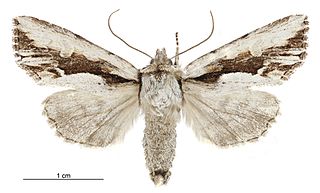
Ichneutica paracausta is a moth of the family Noctuidae. This species is endemic to New Zealand. It is found locally in the central North Island, is widespread in the South Island and can also be found in Stewart Island. I. paracausta is variable in colour, but as it has a distinctive black streak on its forewing as well as a wing pattern that is characteristic, I. paracausta is unlikely to be confused with other species. It is present on the North Island volcanic plateau as well as Little Bush Reserve in Hawkes Bay in the North Island as well as in tussock grassland, alpine and subalpine shrubland and in alpine forest. Larvae have been recorded as feeding on grasses, a pupa has been found in a cocoon under the bark of a tree and adult moths are on the wing from October to January.

Tingena chloritis is a species of moth in the family Oecophoridae. It is endemic to New Zealand and has been found in the South Island. Larvae of this species feed on leaf litter. The adults of this species are light flyers and are attracted to light.
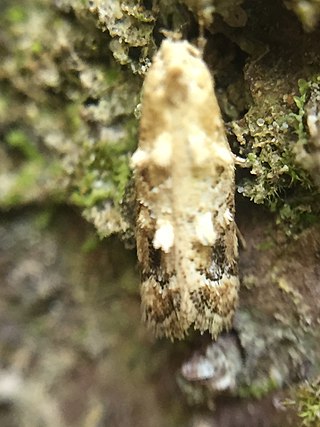
Trachypepla aspidephora is a species of moth in the family Oecophoridae. It is endemic to New Zealand and has been observed in the North and South Islands. Adults are on the wing from November to March and are attracted to light. The moths can be found resting on tree trunks where their colouration imitates lichens.
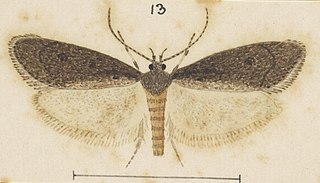
Atomotricha ommatias is a moth in the family Oecophoridae first described by Edward Meyrick in 1883. It is endemic to New Zealand and has been observed in the South Island. This species inhabits shrubland. The adults are out in the spring months of August and September and are attracted to sugar traps. The female of the species os brachypterous and is incapable of flight. Both the male and female of the species have been observed resting on fences during cold nights. The female, if touched, will hop two or three inches.

Trachypepla protochlora is a moth of the family Oecophoridae first described by Edward Meyrick in 1883. It is endemic to New Zealand and is found in both the North and South Islands. The preferred habitat of this species is native forest and adults are on the wing from October until February. Adults can be variable in their green shaded colour as well as in the intensity of markings on their forewings. The greenish ground colouration of this moth ensures they are well camouflaged when at rest on green mosses and lichens.















